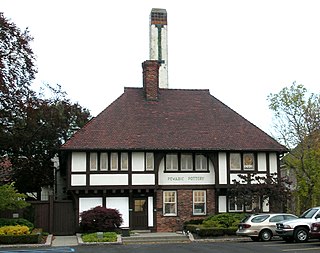
Pewabic Pottery is a ceramic studio and school in Detroit, Michigan. Founded in 1903, the studio is known for its iridescent glazes, some of which grace notable buildings such as the Shedd Aquarium and Basilica of the National Shrine of the Immaculate Conception. The pottery continues in operation today, and was designated a National Historic Landmark in 1991.

The Fox Theatre is a performing arts center located at 2211 Woodward Avenue in Downtown Detroit, Michigan, near the Grand Circus Park Historic District. Opened in 1928 as a flagship movie palace in the Fox Theatres chain, it was at over 5,000 seats the largest theater in the city. Designed by theater architect C. Howard Crane, it was listed on the National Register of Historic Places in 1985.
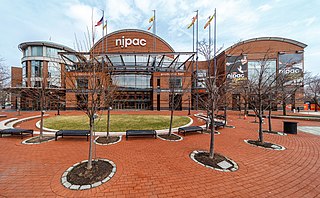
The New Jersey Performing Arts Center (NJPAC), in Downtown Newark in Newark, New Jersey, is one of the largest performing arts centers in the United States. Home to the New Jersey Symphony Orchestra (NJSO), more than nine million visitors have visited the center since it opened in October 1997 on the site of the former Military Park Hotel.
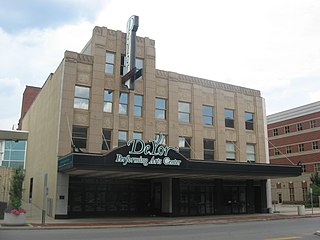
Powers Auditorium, in Youngstown, Ohio is one of the largest auditoriums in the Youngstown-Warren area. The facility is the main venue of downtown Youngstown's DeYor Performing Arts Center. The complex also includes the Adler Art Academy, Beecher Flad Pavilion, and Ford Family Recital Hall. Originally built in 1931 as the Warner Theatre, the former movie palace was renovated and reopened as Powers Auditorium in 1969.

The Gem Theatre is a historic movie theater building located in Detroit, Michigan. Built in 1927, it shares a lobby with the older Century Theatre next door. The National Register of Historic Places listed both theatres together in 1985 and they were relocated in 1997 to prevent demolition. The Gem now serves as a wedding venue and location for other events.

The Lyric Baltimore is a music venue in Baltimore, Maryland, United States, located close to the University of Baltimore law school. The building was modeled after the Concertgebouw concert hall in Amsterdam, and it was inaugurated on October 31, 1894, with a performance by the Boston Symphony Orchestra and Australian opera singer Nellie Melba as the featured soloist. Beginning in 1904, it was also used for touring performances by the Metropolitan Opera, and from 1950, it was the home of the Baltimore Opera Company until that company's liquidation in 2009.
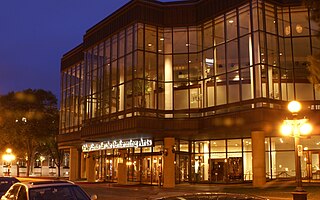
The Ordway Center for the Performing Arts, in downtown Saint Paul, Minnesota, hosts a variety of performing arts, such as touring Broadway musicals, orchestra, opera, and cultural performers, and produces local musicals. It is home to several local arts organizations, including the Minnesota Opera, The Saint Paul Chamber Orchestra, and The Schubert Club. The president and CEO, Christopher Harrington, has served since November 2021, and Producing Artistic Director Rod Kaats has been with the Ordway since February 2018.
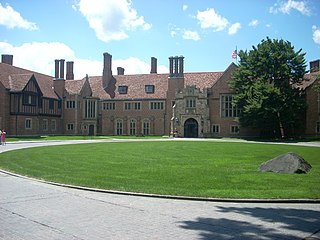
Meadow Brook Hall is a Tudor revival style mansion located at 350 Estate Drive in Rochester Hills, Michigan. It was built between 1926 and 1929 by the heiress to the Dodge automaker fortune, Matilda Dodge Wilson and her second husband, lumber baron, Alfred Wilson. Covering 88,000 square feet (8,200 m2) with 110 rooms, the structure is the fourth largest historic mansion museum in the United States, and is classified as one of America's Castles. In 1957, the mansion and the surrounding property and buildings were donated to the state of Michigan in order to fund Michigan State University–Oakland, now known as Oakland University. The structure was named a National Historic Landmark in 2012.
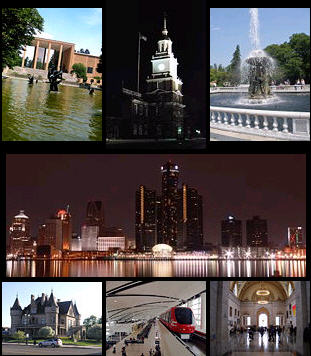
Tourism in metropolitan Detroit, Michigan is a significant factor for the region's culture and for its economy, comprising nine percent of the area's two million jobs. About 19 million people visit Metro Detroit spending an estimated 6 billion in 2019. In 2009, this number was about 15.9 million people, spending an estimated $4.8 billion. Detroit is one of the largest American cities and metropolitan regions to offer casino resort hotels. Leading multi-day events throughout Metro Detroit draw crowds of hundreds of thousands to over three million people. More than fifteen million people cross the highly traveled nexus of the Ambassador Bridge and the Detroit-Windsor Tunnel annually. Detroit is at the center of an emerging Great Lakes Megalopolis. An estimated 46 million people live within a 300-mile (480 km) radius of Metro Detroit.
The Nederlander Organization, founded in 1912 by David T. Nederlander in Detroit, and currently based in New York City, is one of the largest operators of live theaters and music venues in the United States. Its first acquisition was a lease on the Detroit Opera House in 1912. The building was demolished in 1928. It later operated the Shubert Lafayette Theatre until its demolition in 1964 and the Riviera Theatre, both in Detroit. Since then, the organization has grown to include nine Broadway theaters, making it the second-largest owner of Broadway theaters after the Shubert Organization, and a number of theaters across the United States, including five large theaters in Chicago, plus three West End theatres in London.

The Victoria Theatre is a historic 1,154-seat performing arts venue located in downtown Dayton, Ohio. The Victoria hosts a variety of events including theatre, music, dance, film, and comedy.

The Women's City Club is a women's club located at 2110 Park Avenue in Downtown Detroit, Michigan, within the Park Avenue Historic District. It was listed on the National Register of Historic Places and designated a Michigan State Historic Site in 1979.

The Monroe Avenue Commercial Buildings, also known as the Monroe Block, is a historic district located along a block-and-a-half stretch at 16-118 Monroe Avenue in Detroit, Michigan, just off Woodward Avenue at the northern end of Campus Martius. The district was designated a Michigan State Historic Site in 1974 and listed on the National Register of Historic Places in 1975. The thirteen original buildings were built between 1852 and 1911 and ranged from two to five stories in height. The National Theatre, built in 1911, was the oldest surviving theatre in Detroit, a part of the city's original theatre district of the late 19th century, and the sole surviving structure from the original Monroe Avenue Commercial Buildings historic period.

The Majestic Theatre is a theatre located at 4126-4140 Woodward Avenue in Midtown Detroit, Michigan. It was listed on the National Register of Historic Places in 2008.

The Players is a clubhouse and theatre located at 3321 East Jefferson Avenue in Detroit, Michigan. It was designated a Michigan State Historic Site in 1985 and listed on the National Register of Historic Places in 1987.

The Kingston Arms Apartments is an apartment building located at 296 East Grand Boulevard in Detroit, Michigan, in the East Grand Boulevard Historic District. It was listed on the National Register of Historic Places in 1999. The Kingston Arms, built in 1924, is a representative example of the rise of middle-class apartment buildings in pre-Depression era Detroit.
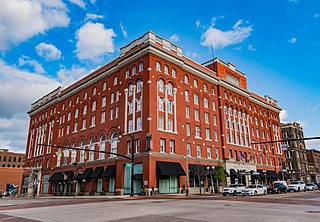
The Great Southern Hotel & Theatre is an historic hotel and theater building in Downtown Columbus, Ohio. The building currently operates as the Westin Great Southern Columbus and the Southern Theatre.

Matilda Dodge Wilson was an American politician and heiress who was the 43rd Lieutenant Governor of Michigan. Ranked as one of the wealthiest women in the world, she was the widow of John Francis Dodge, who co-founded the Dodge motor car company in Detroit with his brother Horace Elgin Dodge. She co-founded the Oakland campus of Michigan State University, now Oakland University, with her husband Alfred Wilson, and John A. Hannah. The new university was built on her 1,400-acre (5.7 km2) estate, Meadow Brook Farms.

Newark Symphony Hall is a performing arts center located at 1020 Broad Street in Newark, New Jersey. Built in 1925, it was added to the National Register of Historic Places in 1977. It was known for many years as The Mosque Theater, and is the former home of the New Jersey Symphony Orchestra, New Jersey State Opera and the New Jersey Ballet Company.
The performing arts in Detroit include orchestra, live music, and theater, with more than a dozen performing arts venues. The stages and old time film palaces are generally located along Woodward Avenue, the city's central thoroughfare, in the Downtown, Midtown, and New Center areas. Some additional venues are located in neighborhood areas of the city. Many of the city's significant historic theaters have been revitalized.
























